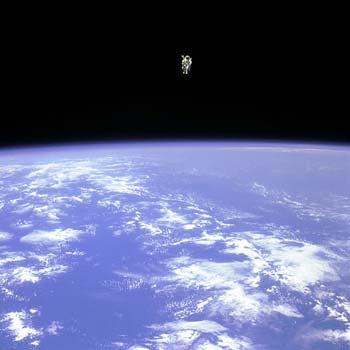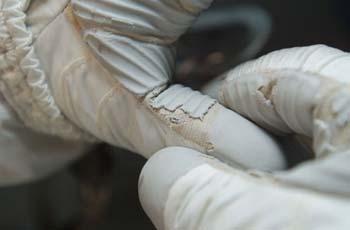Source: nasa
09-18-2008 16:02
An EVA is dangerous for a number of different reasons. The primary one is collision with space debris. Orbital velocity at 300 km above the Earth (typical for a space shuttle mission) is 7.7 km/s.
 |
| At about 100 meters from the cargo bay of the space shuttle Challenger, Bruce McCandless II was further out than anyone had ever been before. Guided by a Manned Maneuvering Unit (MMU), astronaut McCandless, pictured above, was floating free in space. McCandless and fellow NASA astronaut Robert Stewart were the first to experience such an "untethered space walk" during Space Shuttle mission 41-B in 1984. |
Every space mission creates more orbiting debris, so this problem will continue to worsen (see also Kessler Syndrome).
Another reason for danger is that external environments in space are harder to simulate before the mission, though approximate simulations can be achieved at facilities like the Hydro-lab in Star City's Gagarin Training Center and NASA's Neutral Buoyancy Laboratory. Space walks are avoided for routine tasks because of their danger. As a result the EVAs are often planned late in the project development when problems are discovered, or sometimes even during an operational mission. The exceptional danger involved in EVAs inevitably leads to emotional pressures on astronauts.
Other possible problems include a space walker becoming separated from his or her craft or suffering a spacesuit puncture which would depressurize the suit, causing anoxia and rapid death if the space walker is not brought into a pressurized spacecraft quickly.
One astronaut has suffered a spacesuit puncture. During STS-37, a small rod punctured the glove of one of the astronauts (the name is undisclosed, but it was either Jerry L. Ross or Jay Apt). However, the puncturing object held in place, resulting in no detectable depressurization. In fact, the puncture was not noticed until after the space walkers were safely back inside Atlantis
Alexey Leonov's EVA did not pass smoothly either. During the EVA, Leonov's suit had become overinflated to the point he could no longer re-enter and seal the door of the airlock on Voskhod 2. Because he was breathing pure oxygen, he was able to reduce his suit pressure to under 4 psi (28 kPa) and, with much effort, climb back inside.
 |
| Close up view of an apparent hole found in a glove of astronaut Rick Mastracchio during the third EVA of Mission STS-118. |
As of 2008, no catastrophic incident has ever occurred during an extra-vehicular activity, and no astronaut or cosmonaut has ever died during one. However, given the considerable hazards inherent in EVAs, and the resultant risk to astronauts, some scientists are working to develop tele-operated robots for outside construction work, to potentially eliminate or reduce the need for human EVAs.
